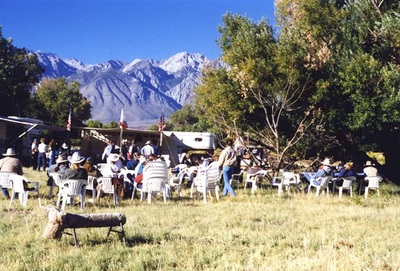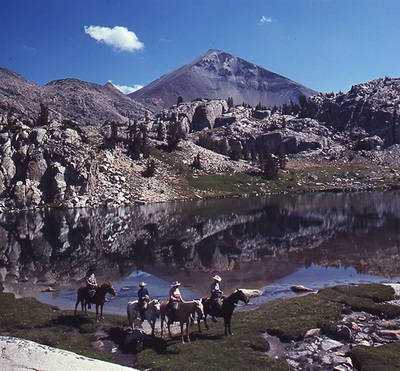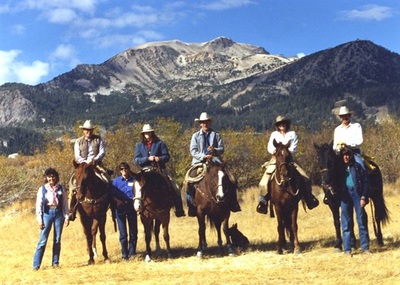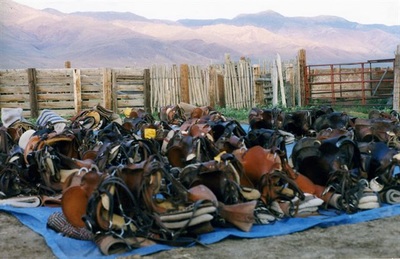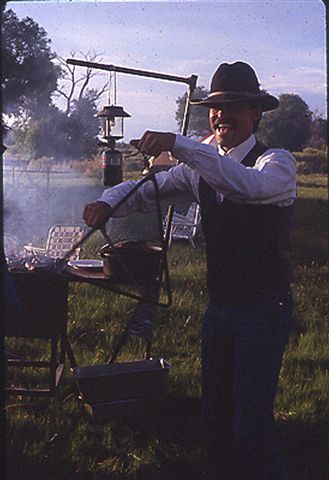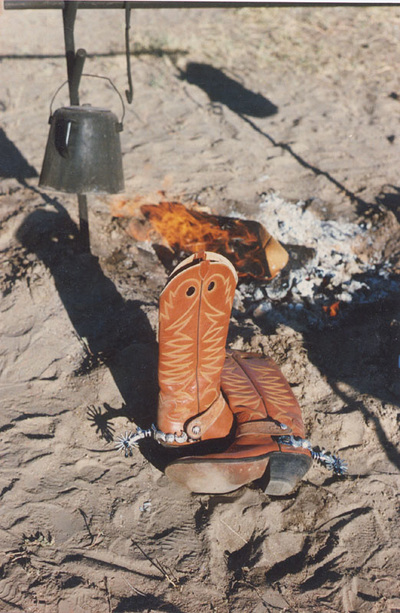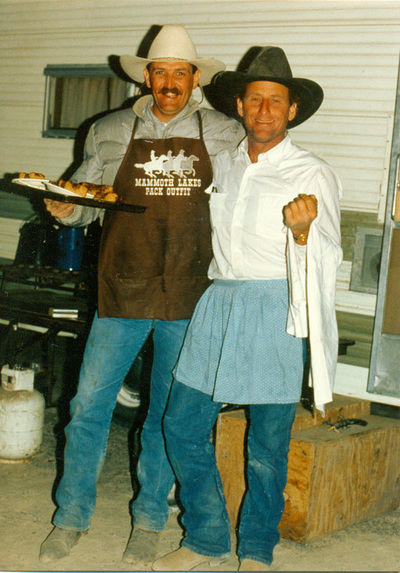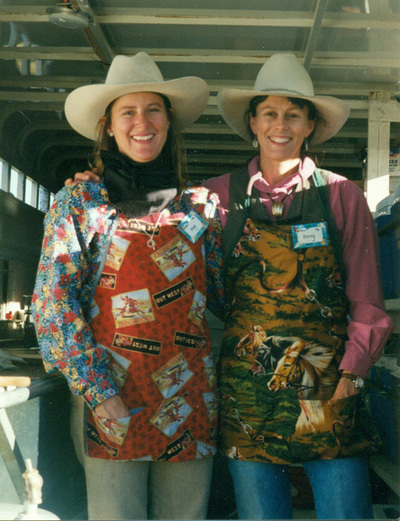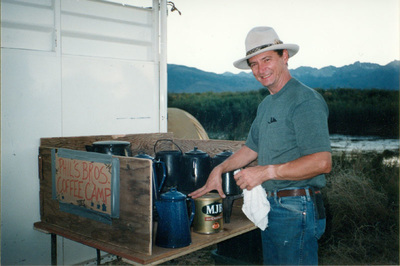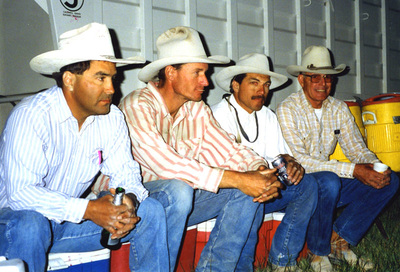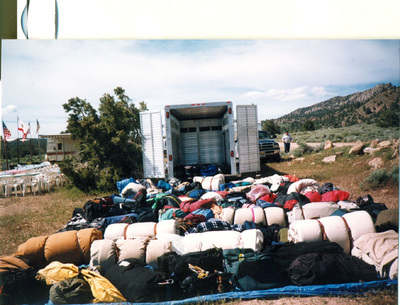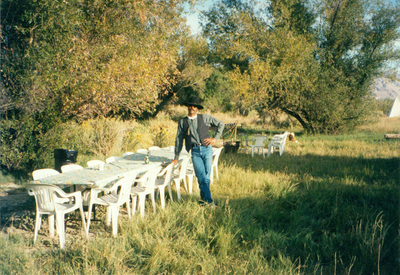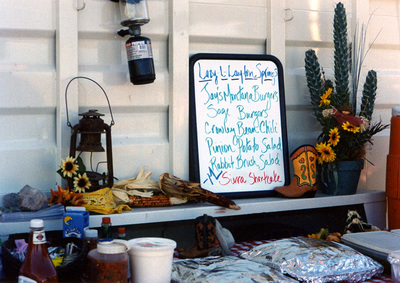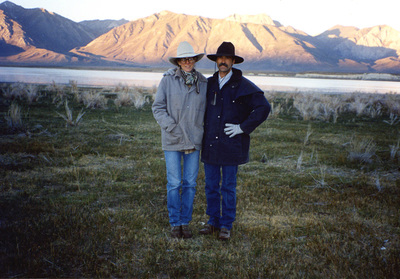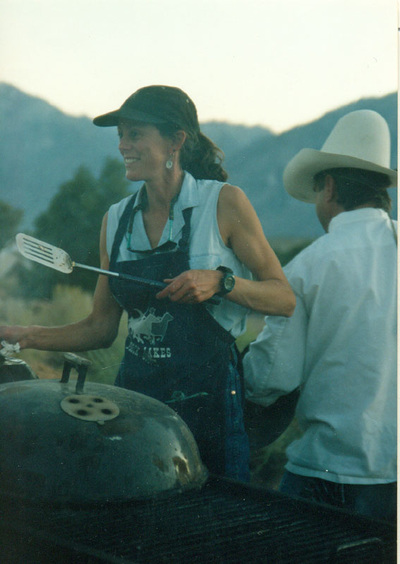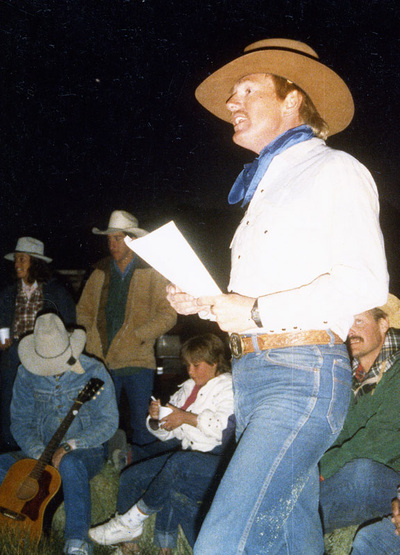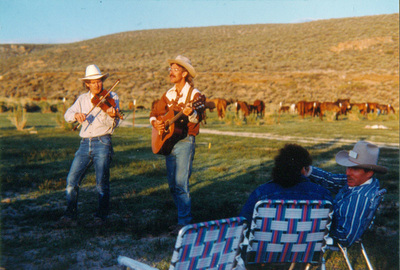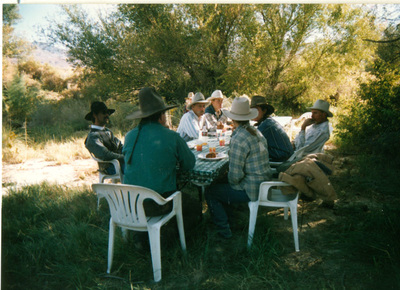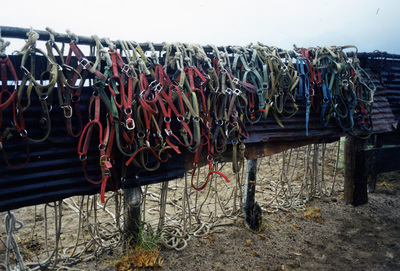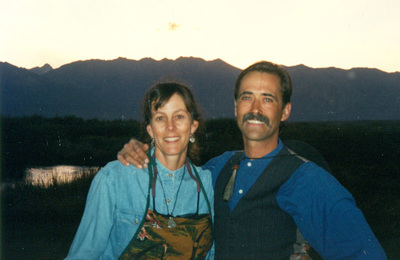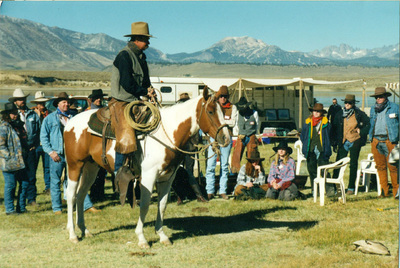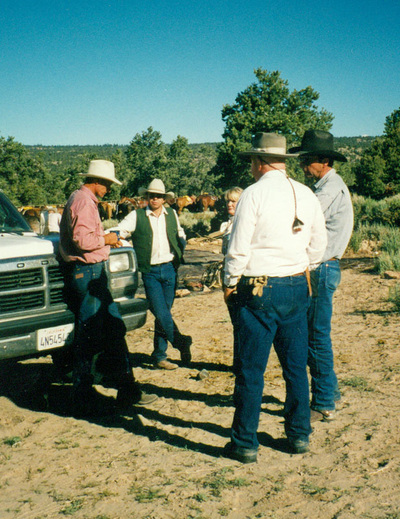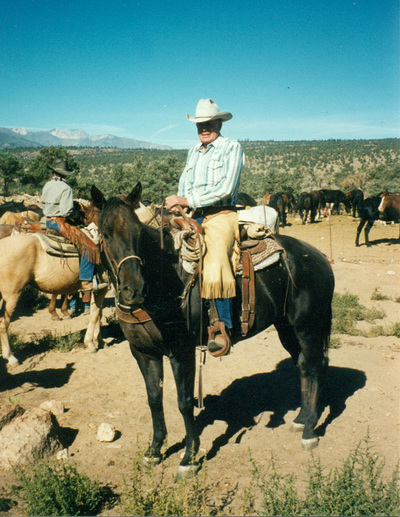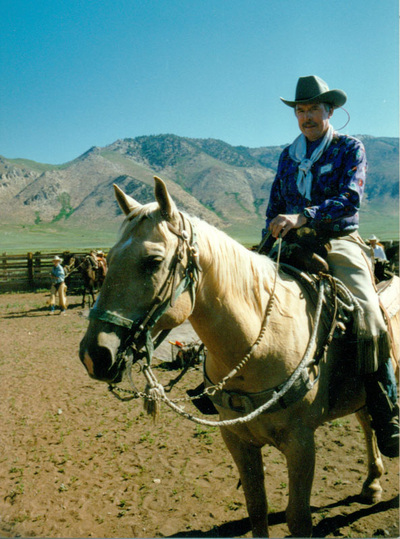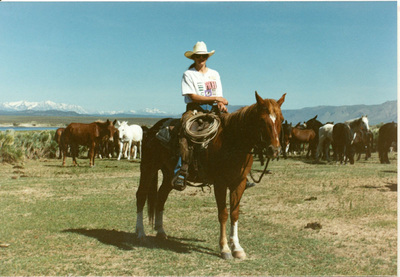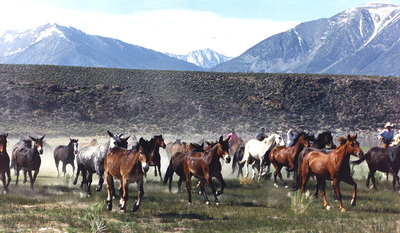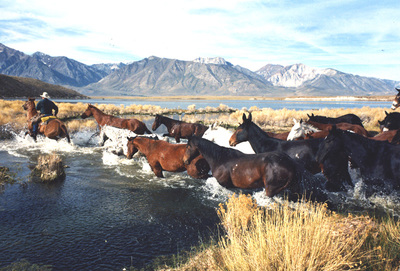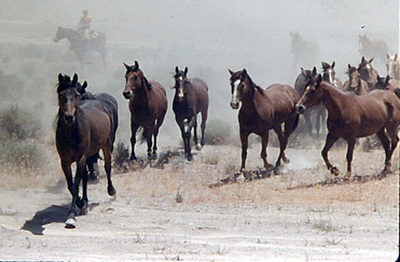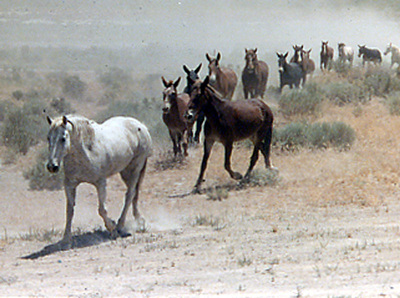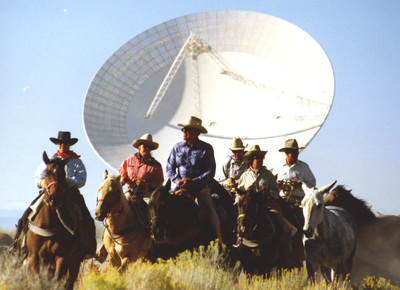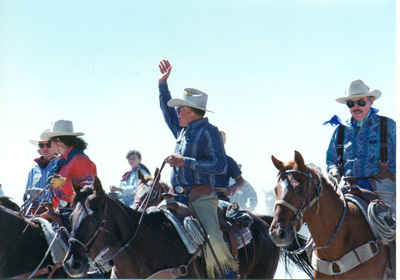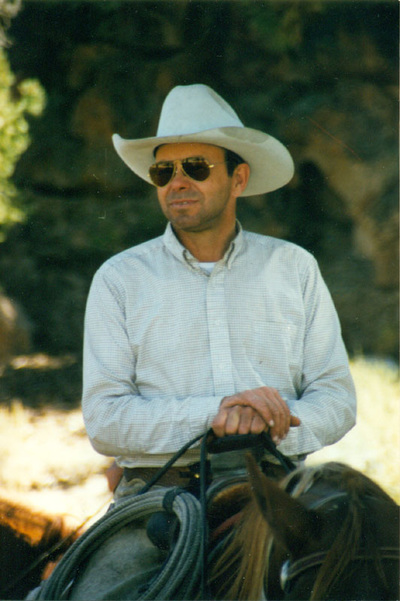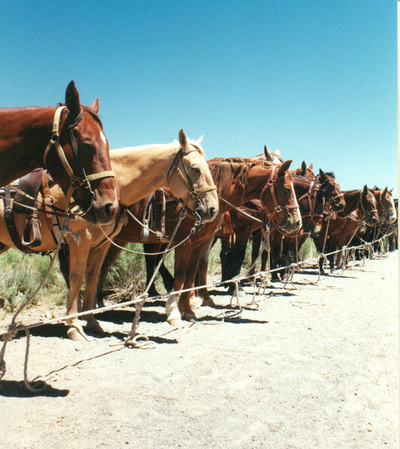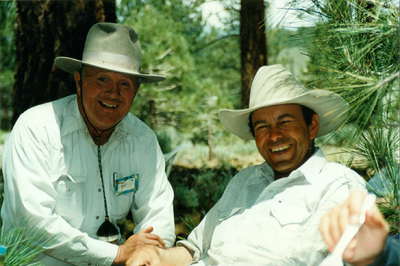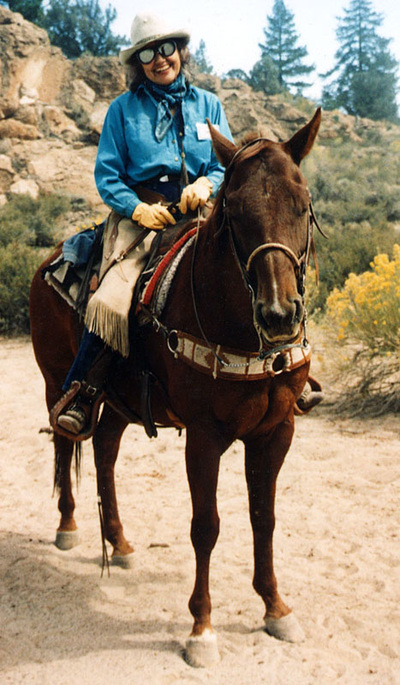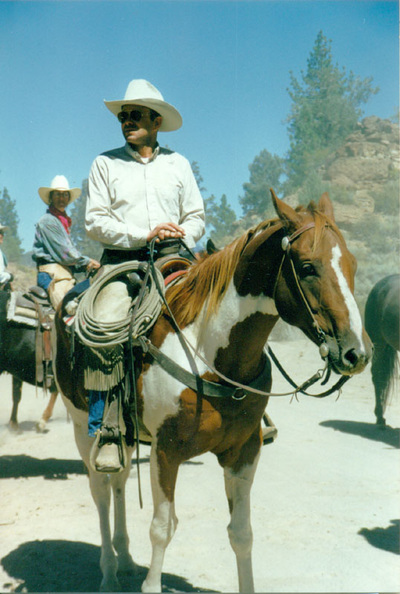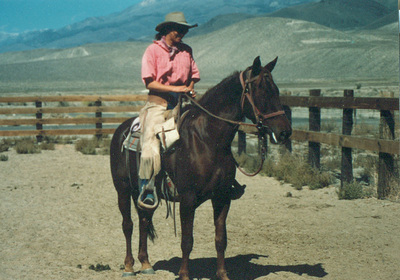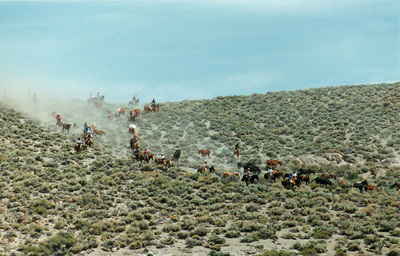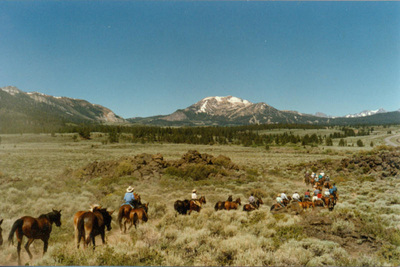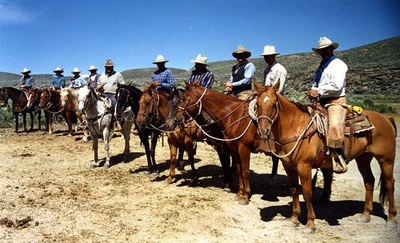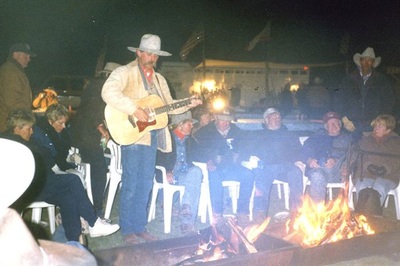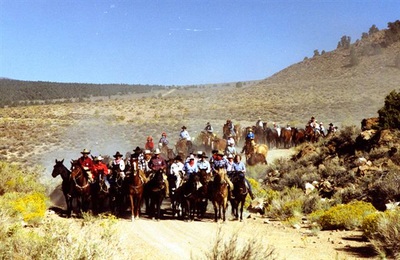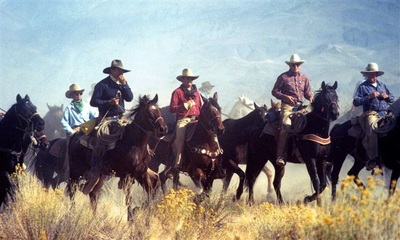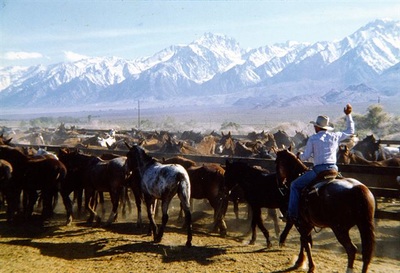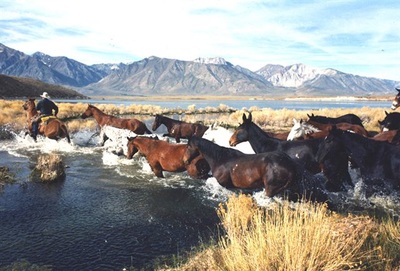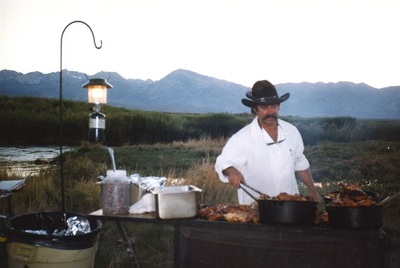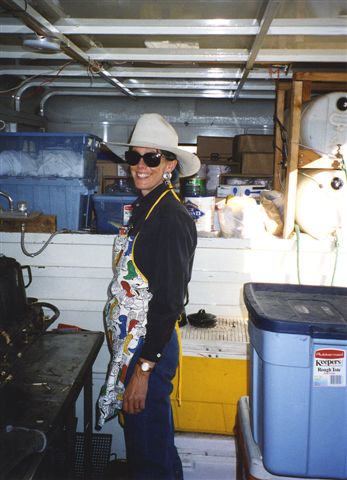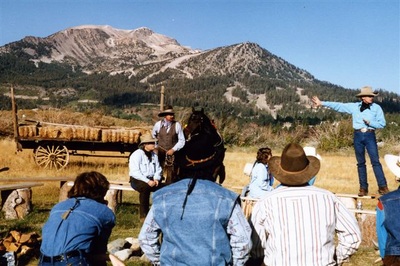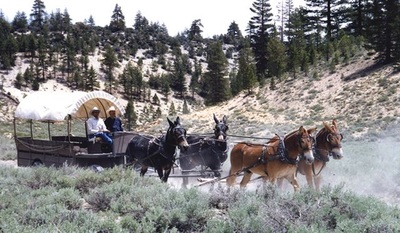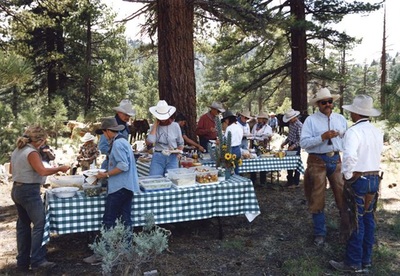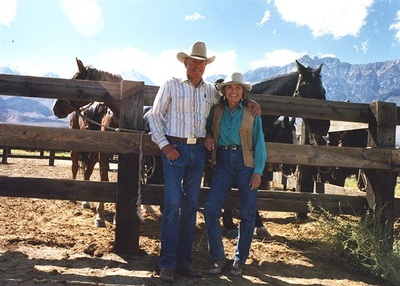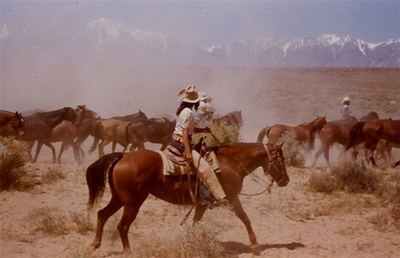by Marye Roeser
|
Dust swirled around the running horses and mules as they loped into the Layton Springs pasture on the northeast shore of shimmering Crowley Lake in Eastern California. Riders emerged through the dusty haze whooping at the stock as the herd thundered into the grassy field.
Under the direction of Lou Roeser, the Mammoth Lakes Pack Outfit moved over one hundred and fifty head of horses and mules between summer pack station headquarters at Lake Mary in Mammoth Lakes, California and winter pasture in the Owens Valley twice each year. During the busy summer season, the packers, wranglers, horses and mules worked steadily packing in vacationers and their gear into the John Muir Wilderness Area. The return trip to winter pasture is over 100 miles in length with five days of hard riding from Mammoth Lakes to the 5,500 acre winter pasture near Fort Independence. The historic old-time pack outfit was owned and operated by Lou and Marye Roeser and their family from 1960 to 1998. The trails followed by the Outfit on their annual Horse Drives have been used for 150 years by ranchers driving their herds of cattle, sheep, horses and mules back and forth to summer pasture in Long Valley and winter pasture in the Owens Valley. Early ranchers, often following Indian trails, created these trails. The trails were known by various names such as the Rickey Trail, the Dry Trail, the Casa Diablo Trail and the Sherwin Hill Trail. Roeser pioneered the routes used on this modern Trail Drive. The terrain today was on trails and dirt roads with few fences. The Outfit resumed the traditional Horse Drives to and from winter pasture in 1975 when it became increasingly difficult to locate livestock haulers who still used single-deck livestock trailers. Horses do not fit in the double-decker cattle and sheep trailers used by modern stock ranchers. Before the advent of cattle trucks and trailers, pack station operators and ranchers, drove their livestock to summer headquarters in these mountains from their winter ranches in the Owens Valley and returned to the valley in the fall. The current Trail Drive accommodated fifty or more guests and 30 crewmembers. Clients of the pack station were working members of the Drive learning that moving horses and mules is quite different than herding cattle. Guests and crew camped out together along the trail. At each night's stop, a fenced pasture, holding pen or corrals were there for the stock where they were fed and watered. Preparation for the Long Drive had been going on for some time prior to departure. Customer reservations were checked, rechecked and nametags printed out. This Drive was not for novices or beginning riders so new customers were screened for their riding abilities. The horses were ridden at a jog or trot most of the distance with an average of over 20 miles covered each day. These horses were not trained for the show ring but were steady, sturdy, surefooted mountain horses. Camp equipment was hauled out of the "Big Saddle Shed" and sorted and cleaned. All the equipment had to be in good working order before being loaded into horses trailers and trucks for camp. Folding tables, chairs, tablecloths, lanterns and shade or rain canvas tarps were readied, to be loaded in a horse trailer along with water jugs, firewood, fire pans, BBQ's, charcoal, shovels and rakes. Tepee tents with their porta-potties were loaded in the trailer. At camp, a wash area shelf was hooked onto the side of a horse trailer, complete with wash pans, mirrors, a water tank and even a spray hose for washing hair. No hot water though! Menus had to be finalized and food ordered, pre-cooked, prepared, frozen and ready to pack into many ice chests. In later years, the pack station engineered a kitchen that was inserted into an 8 horse stock trailer that became the chuckwagon. Included were a stove, sinks, a water tank, work counters and storage shelves. Hooks were placed for lanterns to be hung from. There were 3 burner butane stoves for cooking outside the trailers. Cowboy coffee always simmered on one of these burners or hung on a hook over the campfire. Another 8 horse stock trailer was the "bed wagon" and all bedrolls and duffle bags were transported to each camp. Guests brought their own bedrolls and personal tents and were responsible for setting them up each night and packing them up again each morning. Horses had to be checked out for shoes and reshod if necessary. Saddles, bridles, pads and blankets were all readied. Each guest had an identifying tag attached to their saddle to help them identify the saddle assigned to them. Shoeing kits, grooming tools and vet boxes were loaded up. A water truck with a 2,000 gallon water tank for stock water and large water troughs accompanied the Drive on what was called the "Dry Trail". The hay truck was a pickup truck with a flatbed trailer and was loaded each day with alfalfa hay for the evening. Catch grain was carried for morning treats for the saddle horses. The day before the Drive, the stock were hauled or driven down the "hill" to Sierra Meadows Ranch Equestrian Center also owned by the Roesers where the Drive began. The stock was put in the arenas ready for the next morning. Guests checked into local motels for a comfortable bed and a last shower before the dusty drive. McGee Creek Pack Station stock was hauled to the Chance Ranch where they would join the Drive. On the first morning, the wranglers carefully matched riders to their horses and saddles for the five-day drive. Many of the guests returned each year and requested particular mounts for the ride. Lou and Larry gave instructions on what the newcomers should expect and tips on how to ride. Wranglers would be stationed throughout the remuda to assist guests and keep the herd together. New horses and young horses would not be trail wise on the first days of the Drive and riders had to be alert. This morning, the drive departed from Mammoth Lakes at a fast clip, on the first section of a five day odyssey through the sagebrush, pastures and open countryside of Long Valley. When the corral gates were opened, the stock rushed out and had to be quickly guided and bunched up by the experienced riders. Lou had the crew in the front line to keep the stock from running off in various directions. A vehicle or mule drawn wagon accompanied the Drive for rest stops with iced tea, lemonade and water. Tired or sore guests could opt to ride to the lunch stop or night camp. A lunch truck and trailer drove ahead to the lunch stop to set up the lunch buffet before the riders trotted in. After the lunch stop, the Drive continued toward the Upper Owens River and Crowley Lake. Riders were warned that deep, dangerous bogs occurred through the area and often looked like grassy spots among the sagebrush or just a lush meadow area. In the past, horses have had to been dragged out of the treacherous bogs with lariats and a strong horses. Experienced cowboys were always on the lookout for these danger spots. While the Drive was on the trail, a comfortable camp was established on the grassy northeast shore of Crowley Lake with cold beverages and tasty appetizers waiting to refresh tired new range hands. The camp crew led by Mike Elam had the monumental task of moving and setting up camp each day before the drive arrived at the evening campsite. Coals were glowing in the barbecues as riders located a "homestead with a view", spot for their tents. Kerry Roeser Elam and her kitchen crew were putting the finishing touches on the delicious evening dinner. Hard riding in the fresh, clear mountain air creates hearty appetites, and Kerry and her friendly, always smiling kitchen crew met that challenge with delicious home cooked meals to rival the finest urban restaurants. |
The creek from Layton Spring runs into Crowley Lake and the water is somewhat warm. The temperate spring that gushes out of the dry hillside maintains the same temperature year round. Some guests walked over to the pond at the spring for a refreshing dip to wash off the trail dust. Crowley Lake was built by the Los Angeles Department of Water and Power in 1941 to store Mono County water diverted for export to Los Angeles and is famous for its big trout.
Crowley Lake lies along the eastern edge of the Long Valley Caldera that erupted about 730,000 years ago depositing ash for hundreds of miles to the east and creating the volcanic tableland. The elliptical valley is 20 miles long and is about 7,000 feet in elevation while the Sierra Crest, just to the south, has peaks over 13,000 feet. Mammoth Mountain is a volcano located on the western edge of the caldera.
After a scrumptious barbecue dinner, the new trail hands gathered at the campfire to watch a rosy sunset over Mammoth Mountain while talking over exciting events of the day. The pack outfit crew were introduced, cowboy musicians entertained around the campfire, coffee pots were hung over the fire and dessert served as guests huddled close to the campfire. Tired riders soon drifted off to their warm sleeping bags to sleep soundly.
The scent of freshly brewed cowboy coffee wafted through the chill dawn as wranglers brushed and saddled the riding string. A soft mist hung over the lake waters and guests gathered close to the blazing campfire. The breakfast gong and the sizzle of sausage on the grill reminded the "city slicker" cowboys of just how hungry they really were. There were no comments of, "But I never eat breakfast at home."
Lou Roeser, was Trail Boss and he instructed the Cowboys For a Day on planned procedures for the Drive. "Driving horses is quite different than driving cattle! A Horse Drive is more like a holding operation than a pushing one, as most of these horses have been on this trail before, know where they are going and are in a big hurry to get there. Our job is to hold the herd together, keep a good pace and get them safely to Independence in good shape". Larry, camp host announced, "Today, we'll cross Layton Creek, skirt the shore of Crowley Lake, then climb steeply up over Alligator Point to the east of camp. The views of Long Valley and Mammoth Mountain are spectacular up on top. Then, we'll head east to Casa Diablo Mountain and the old sheep camp there."
After the steep climb to the summit, Lou signaled for a rest stop for the stock. The sagebrush covered volcanic tableland stretches to the east and is dotted with Jeffrey pines, pinyon pines and juniper. Lunch stop was in a shady Jeffrey pine forest surrounded by pink Bishop tuff rock that made an easy spot to hold the stock. High lines were stretched between trees and the saddle animals were tied to the lines. Riders took turns holding the herd while others ate lunch. After the warm, dusty climb, the rest under tall pines was welcome.
Casa Diablo Mountain is a granite knob, protruding through the volcanic tuff. This is sheep country and flocks graze the benches during the summer months. Run-off water drains into the porous tuff so there are no running streams only a few springs are located in the tableland. As the Drive trotted into the Casa Diablo camp, on a pinion-covered bench, the crew were waiting with fresh water in the water truck and a load of alfalfa hay hauled in for the herd. Horses and mules nickered in anticipation and some of the guests helped the crew feed the stock in the fenced enclosure.
Riders gratefully located a chair under the shading canvas tarp with a cold drink to recall the adventures of the trip. Lou told the group, "Tomorrow, we'll ride down the volcanic tableland (called the Casa Diablo Grade) to the Laws Corrals in the Owens Valley where we'll be 3,000 feet lower in elevation than when we began our trip. It might even be mild enough for a quick swim in the cool Owens River waters."
Looking toward the Sierra, the camp faced across to Mt. Tom and the great Coyote Warp or bend of the Sierra. The pink glow on Mt. Tom lured photographers and a rising moon made its timely appearance just at campfire time. Brightly colored tents dotted the bench among the trees. Cowboy poetry and western guitar songs ended the evening while a lone coyote added his yip to the ballads. Tired riders and crew reluctantly left the cozy campfire to roll into warm bedrolls. Nights are cool in the mountains and morning comes early.
In the morning, the experienced pack station crew offered riding and horsemanship instruction and pointers to guest riders. This seminar helped the riders to be more comfortable riding on the trip. The wranglers adjusted stirrups and bridles, and tightened cinches. Suddenly everyone was mounted and ready to ride. Lou cautioned, "Stay alert! We'll have to really hold back the herd on the Casa Diablo Hill or they will run all the way to Bishop! Riders stay to the sides of the herd and riders in the back don't push the herd."
Lee Roeser added, "I'll be following behind you with the truck and horse trailer for tired rider or horse transport. When the grade levels out, we'll stop and rest the herd while riders can tank up on liquids. We don't want anyone to become dehydrated on this warm day."
Lou motioned for the packers to make a tight line of riders across the road in front of the herd. The crew had been with the Pack Outfit for years and knew just where to be positioned in order to best control the bunch of eager horses. Other wranglers would be scattered throughout the remuda to assist riders and herd the laggards.
Instructions given, Lou waved his arm signaling, "Move 'em out!" and cowboys opened the corral gate. The herd thundered out and the new trailwise wranglers trotted to the top of the Casa Diablo grade overlooking the golden Owens Valley. As the herd plunged over the crest of the hill, trail dust enveloped the Drive with only the creak of saddle leather, hooves clattering on rocks and occasional hoots defining the riders. The cowboys tightly surrounded the herd containing the animals until they were lined out on the volcanic mesa land. Outriders had to constantly dodge the chollo cactus on the Grade.
There is no shade on this tableland and guests gratefully gathered under the tarps and the shade from the pack station trucks to eat lunch and drink gallons of iced tea. Tie lines were tied between rigs for the saddle horses and the crew and guests took turns keeping the herd bunched up during the lunch stop.
The Drive then continued downward to the Upper Owens Valley and the Laws Corrals. The Owens River has cut a 700-foot deep gorge through the volcanic tableland to reach the floor of the valley. The Laws corrals are part of an old cattle ranch dating back to the 1860's. The ranches in the northern Owens Valley were important supply points for Aurora, Bodie and Mammoth City, early mining boomtowns. The Los Angeles Department of Water and Power began buying most of the Owens Valley in 1905 in order to secure their water rights as they diverted precious water to Los Angeles. There are few privately owned ranches in the valley - all land is leased from the City.
Camp was near the river and many riders took advantage of a cool dip although some gals complained of the muddy (gooey) river bottom. What better way to remove trail dust and wash your hair too! The steaks were cooked just right and the grilled fish fillets were a delightful surprise to the guests. The evening was warm and balmy so a Virginia Reel was called on the flat grassland of the campsite. By now all the riders knew each other and good friendships had formed. Even the hard working crew joined in for the lively dance.
The sun rose early in the eastern sky over the White Mountains. Crew and guests were up early brushing the saddle horses. Guests lingered over morning coffee and enjoyed the hearty breakfast prepared by the pack station kitchen crew. Lou warned the guests that the Drive would have to cross Highway 6 and that the herd had to be gathered up so that all would cross together at once while the crew stopped traffic. Motorists might not be expecting a large horse herd to cross the road in front of them.
After crossing the Highway, the Drive trotted by Laws Station, built in 1883. The station was a major station on the Carson and Colorado Railroad. The narrow gauge engine was affectionately called the "Slim Princess" and it headed up the valley from Laws and over Montgomery Pass to Carson City where it connected with the Virginia and Truckee Railroad.. Traveling south it extended to Keeler at now dry Owens Lake and made connections there with the Southern Pacific Railroad. The Laws Railroad Museum offers a window to that period and the Slim Princess" resides there along with the station, the stationmaster's house and several of the passenger cars. The earliest town in the northern part of the Owens Valley was Owensville, established in 1863, along the Owens River near Laws. The town lasted but 2 years. A talc mill and cattle and hay ranches dot the area now.
Marye informed the group, "From here to Zurich, an old shipping station on the old narrow gauge railroad, we will follow the route of the Carson and Colorado Railroad. There is little to see of the tracks now, only an occasional weathered railroad tie. But, iron spikes can still be found jutting out of the sand".
Day four was the longest stretch of trail on the "Long Dry Trail" as the riders pointed the herd southeast along the base of the abrupt White Mountains. White Mountain Peak at 14,246 feet is the third highest mountain in California, only slightly lower than the tallest Mount Whitney at 14, 494 feet not far south from here. Death Valley, to the east, is below sea level. The Owens Valley is a long narrow block of the earth's crust, which was down dropped between two uplifted fault block mountain ranges on the east and west. The Sierra Nevada range is on the west and the White/Inyo Range is on the east with great fault escarpments of each range bordering the valley.
Cottonwoods and willow trees lining the Owens River banks had turned a bright yellow to match the blooming rabbit brush. In 1860, the valley had few trees and grass only along the river and sloughs. Early ranchers diverted water and developed the grasslands seen today. The Owens River, (called Wakopee by the Paiute Indians), was named by John C. Fremont for Richard Owens, a member of his 1845-46 expedition.
Riders and stock settled into their pace for the remainder of the trip. Strings of mules that were used to trailing together along narrow mountain trails, now strung along through the sagebrush and much whinnying occurred when they became separated. Guests and crew conversed together as they chased after strays, blocked cattle guards, and held the herd together. They had to be alert to dodge dangerous snarls of old barbed wired lying on the ground, remnants of the many small ranches that used to mark the Owens Valley. Young horses still looked for a chance to break free of the remuda and dash to the river. "Do I see an iron spike over there?" called out Marye.
Seasoned horse drivers assured their friends, "See, I told you --- isn't this great! It's just like, "The Man From Snowy River!" Nervous first time riders now began to relax and muse, "Hey, I am really doing it! I have always had a secret dream to ride with the cowboys and now I am!"
The Cal Tech Radio Observatory towers are just north of Zurich and the towers are focused on far distant quasars in space. Modern technology meets old time frontier action as the herd loped by. The sun was setting behind the high Palisade crags and the glaciers looming above, when the herd trotted into ranch corrals at Zurich another old station on the railroad line. Camp was nestled in a shady cluster of willow trees along the grassy riverbank and dinner was simmering. The evening was balmy, crickets hummed, frogs croaked and an occasional owl was heard.
The last night was traditionally a humorous "awards" program hosted by cowboy poet, Larry Maurice. Serious awards were also earned. After 10 horse drives, a silver buckle was awarded, at 15 Drives spurs were presented, and at 20 drives a silver bit was awarded. The guests enjoyed old-fashioned peach cobbler and the campfire burned late as guests savored their last night in camp together and requested their favorite western songs from Dave Stamey.
The final morning arrived early with everyone a little sad that the end of the trail was almost in sight. Some of the crew and previous horse drivers related the story of a stampede on an earlier drive to the new guests.
"The Owens Valley is a practice training area for military fighter jets and were expected throughout the lower valley. However, this last morning, we had left Tinnemaha Reservoir and were proceeding to the lunch stop near Aberdeen. Two fighter jets suddenly appeared above us traveling toward the south when they had spotted the herd with its trail of tell tail dust. Lou said, "Oh, Oh, Trouble!" as he noticed the jets circling to the west. Sure enough, they circled around, dove low and came directly at us one behind the other. They were flying so low, we could see the pilots and I swear we could see them smiling. They were directly on top of us when the first sonic boom hit. The herd jumped in unison and then the 2nd sonic boom from the second fighter plane hit us."
"It was an all out stampede! The loose stock immediately outran the riders who were trying to control their mounts and it looked as though they wouldn't stop before Independence. Hats went sailing off into the sagebrush but nobody fell off! The crew in the front took out after the leaders to stop them. Other crew and guests gathered up the slower horses and attempted to slow the remainder of the herd down. The wild bunch ran quite a ways before they were stopped and held up by the cowboys. Several wranglers looked for lost hats in the desert brush. The rest of the Drive eventually caught up to the still nervous loose herd and we then continued on to the lunch stop. The horses and mules were still so jittery that we all ate our lunch in the saddle. The crew made up sandwiches to order and delivered them to us. Lou and the crew were really proud of the guests and the job that we did! The whole story was recounted at the evening campfire."
This Drive passed above the east side of Tinnemaha Reservoir, a water storage lake for the aqueduct system and suddenly a small herd of tule elk were spotted angling in front of the Drive. The tule elk, a smaller relative of the Roosevelt elk, were transplanted to the Owens Valley in the 1930's from the Central Valley, have thrived and now number about 2,000 animals. The stock did not spook at the elk herd because they are well acquainted with them in the horse pasture.
At Aberdeen, another old station site, a thick, shady grove of trees sheltered the lunch stop along Goodale Creek. How wonderful it felt to wash the alkali dust off your face in the icy stream. Saddle horses were tied to picket lines in the shade of the grove while the remuda was turned out into a nearby corral. The colorful daily lunch buffet featured gourmet salads, fruits and a well stocked sandwich bar to tempt the hungry buckaroos!
The Independence pasture is located just north of Fort Independence on the east side of the Los Angeles Aqueduct. The 5,500 acre field extends from the aqueduct canal to the base of the Inyo Mountains and lies at about 4300 feet elevation. The pack station leased the pasture from the Department of Water and Power as winter grazing for the horses and mules.
The riders mounted up one last time, and watered the herd in Goodale Creek before pointing the remuda south on the last leg of the long journey. Horses and Mules were eager now as they sensed that the pasture was just ahead with grass, ponds and a winter of leisure awaiting them.
Driving the herd along the one lane dirt aqueduct canal road to the pasture was rather tense. The straight sided canal banks and deep water prevented a horse from scrambling out should one slip in. Two horses had to be dragged out of the canal with ropes on earlier drives. Crew riders were very vigilant on this last stretch of the Drive. At last, the pasture gate was opened and the bunch poured through, headed for the wooden corrals. The next day the pack station crew would pull shoes, trim feet, brand new animals with the ML brand and worm the herd before turning them out for the winter. The McGee Creek Pack Station animals were sorted out and transported over to their winter headquarters at 8-Mile Ranch.
It was time for last photos, reluctant goodbyes, and "Kerry, put me on the list for the Spring Drive!" Riders would head back to their other urban lives, but only until the Spring Drive, when the horses and mules would again be pointed north on the 100-mile "Long Drive" to the high mountains of California's Sierra Nevada.
Crowley Lake lies along the eastern edge of the Long Valley Caldera that erupted about 730,000 years ago depositing ash for hundreds of miles to the east and creating the volcanic tableland. The elliptical valley is 20 miles long and is about 7,000 feet in elevation while the Sierra Crest, just to the south, has peaks over 13,000 feet. Mammoth Mountain is a volcano located on the western edge of the caldera.
After a scrumptious barbecue dinner, the new trail hands gathered at the campfire to watch a rosy sunset over Mammoth Mountain while talking over exciting events of the day. The pack outfit crew were introduced, cowboy musicians entertained around the campfire, coffee pots were hung over the fire and dessert served as guests huddled close to the campfire. Tired riders soon drifted off to their warm sleeping bags to sleep soundly.
The scent of freshly brewed cowboy coffee wafted through the chill dawn as wranglers brushed and saddled the riding string. A soft mist hung over the lake waters and guests gathered close to the blazing campfire. The breakfast gong and the sizzle of sausage on the grill reminded the "city slicker" cowboys of just how hungry they really were. There were no comments of, "But I never eat breakfast at home."
Lou Roeser, was Trail Boss and he instructed the Cowboys For a Day on planned procedures for the Drive. "Driving horses is quite different than driving cattle! A Horse Drive is more like a holding operation than a pushing one, as most of these horses have been on this trail before, know where they are going and are in a big hurry to get there. Our job is to hold the herd together, keep a good pace and get them safely to Independence in good shape". Larry, camp host announced, "Today, we'll cross Layton Creek, skirt the shore of Crowley Lake, then climb steeply up over Alligator Point to the east of camp. The views of Long Valley and Mammoth Mountain are spectacular up on top. Then, we'll head east to Casa Diablo Mountain and the old sheep camp there."
After the steep climb to the summit, Lou signaled for a rest stop for the stock. The sagebrush covered volcanic tableland stretches to the east and is dotted with Jeffrey pines, pinyon pines and juniper. Lunch stop was in a shady Jeffrey pine forest surrounded by pink Bishop tuff rock that made an easy spot to hold the stock. High lines were stretched between trees and the saddle animals were tied to the lines. Riders took turns holding the herd while others ate lunch. After the warm, dusty climb, the rest under tall pines was welcome.
Casa Diablo Mountain is a granite knob, protruding through the volcanic tuff. This is sheep country and flocks graze the benches during the summer months. Run-off water drains into the porous tuff so there are no running streams only a few springs are located in the tableland. As the Drive trotted into the Casa Diablo camp, on a pinion-covered bench, the crew were waiting with fresh water in the water truck and a load of alfalfa hay hauled in for the herd. Horses and mules nickered in anticipation and some of the guests helped the crew feed the stock in the fenced enclosure.
Riders gratefully located a chair under the shading canvas tarp with a cold drink to recall the adventures of the trip. Lou told the group, "Tomorrow, we'll ride down the volcanic tableland (called the Casa Diablo Grade) to the Laws Corrals in the Owens Valley where we'll be 3,000 feet lower in elevation than when we began our trip. It might even be mild enough for a quick swim in the cool Owens River waters."
Looking toward the Sierra, the camp faced across to Mt. Tom and the great Coyote Warp or bend of the Sierra. The pink glow on Mt. Tom lured photographers and a rising moon made its timely appearance just at campfire time. Brightly colored tents dotted the bench among the trees. Cowboy poetry and western guitar songs ended the evening while a lone coyote added his yip to the ballads. Tired riders and crew reluctantly left the cozy campfire to roll into warm bedrolls. Nights are cool in the mountains and morning comes early.
In the morning, the experienced pack station crew offered riding and horsemanship instruction and pointers to guest riders. This seminar helped the riders to be more comfortable riding on the trip. The wranglers adjusted stirrups and bridles, and tightened cinches. Suddenly everyone was mounted and ready to ride. Lou cautioned, "Stay alert! We'll have to really hold back the herd on the Casa Diablo Hill or they will run all the way to Bishop! Riders stay to the sides of the herd and riders in the back don't push the herd."
Lee Roeser added, "I'll be following behind you with the truck and horse trailer for tired rider or horse transport. When the grade levels out, we'll stop and rest the herd while riders can tank up on liquids. We don't want anyone to become dehydrated on this warm day."
Lou motioned for the packers to make a tight line of riders across the road in front of the herd. The crew had been with the Pack Outfit for years and knew just where to be positioned in order to best control the bunch of eager horses. Other wranglers would be scattered throughout the remuda to assist riders and herd the laggards.
Instructions given, Lou waved his arm signaling, "Move 'em out!" and cowboys opened the corral gate. The herd thundered out and the new trailwise wranglers trotted to the top of the Casa Diablo grade overlooking the golden Owens Valley. As the herd plunged over the crest of the hill, trail dust enveloped the Drive with only the creak of saddle leather, hooves clattering on rocks and occasional hoots defining the riders. The cowboys tightly surrounded the herd containing the animals until they were lined out on the volcanic mesa land. Outriders had to constantly dodge the chollo cactus on the Grade.
There is no shade on this tableland and guests gratefully gathered under the tarps and the shade from the pack station trucks to eat lunch and drink gallons of iced tea. Tie lines were tied between rigs for the saddle horses and the crew and guests took turns keeping the herd bunched up during the lunch stop.
The Drive then continued downward to the Upper Owens Valley and the Laws Corrals. The Owens River has cut a 700-foot deep gorge through the volcanic tableland to reach the floor of the valley. The Laws corrals are part of an old cattle ranch dating back to the 1860's. The ranches in the northern Owens Valley were important supply points for Aurora, Bodie and Mammoth City, early mining boomtowns. The Los Angeles Department of Water and Power began buying most of the Owens Valley in 1905 in order to secure their water rights as they diverted precious water to Los Angeles. There are few privately owned ranches in the valley - all land is leased from the City.
Camp was near the river and many riders took advantage of a cool dip although some gals complained of the muddy (gooey) river bottom. What better way to remove trail dust and wash your hair too! The steaks were cooked just right and the grilled fish fillets were a delightful surprise to the guests. The evening was warm and balmy so a Virginia Reel was called on the flat grassland of the campsite. By now all the riders knew each other and good friendships had formed. Even the hard working crew joined in for the lively dance.
The sun rose early in the eastern sky over the White Mountains. Crew and guests were up early brushing the saddle horses. Guests lingered over morning coffee and enjoyed the hearty breakfast prepared by the pack station kitchen crew. Lou warned the guests that the Drive would have to cross Highway 6 and that the herd had to be gathered up so that all would cross together at once while the crew stopped traffic. Motorists might not be expecting a large horse herd to cross the road in front of them.
After crossing the Highway, the Drive trotted by Laws Station, built in 1883. The station was a major station on the Carson and Colorado Railroad. The narrow gauge engine was affectionately called the "Slim Princess" and it headed up the valley from Laws and over Montgomery Pass to Carson City where it connected with the Virginia and Truckee Railroad.. Traveling south it extended to Keeler at now dry Owens Lake and made connections there with the Southern Pacific Railroad. The Laws Railroad Museum offers a window to that period and the Slim Princess" resides there along with the station, the stationmaster's house and several of the passenger cars. The earliest town in the northern part of the Owens Valley was Owensville, established in 1863, along the Owens River near Laws. The town lasted but 2 years. A talc mill and cattle and hay ranches dot the area now.
Marye informed the group, "From here to Zurich, an old shipping station on the old narrow gauge railroad, we will follow the route of the Carson and Colorado Railroad. There is little to see of the tracks now, only an occasional weathered railroad tie. But, iron spikes can still be found jutting out of the sand".
Day four was the longest stretch of trail on the "Long Dry Trail" as the riders pointed the herd southeast along the base of the abrupt White Mountains. White Mountain Peak at 14,246 feet is the third highest mountain in California, only slightly lower than the tallest Mount Whitney at 14, 494 feet not far south from here. Death Valley, to the east, is below sea level. The Owens Valley is a long narrow block of the earth's crust, which was down dropped between two uplifted fault block mountain ranges on the east and west. The Sierra Nevada range is on the west and the White/Inyo Range is on the east with great fault escarpments of each range bordering the valley.
Cottonwoods and willow trees lining the Owens River banks had turned a bright yellow to match the blooming rabbit brush. In 1860, the valley had few trees and grass only along the river and sloughs. Early ranchers diverted water and developed the grasslands seen today. The Owens River, (called Wakopee by the Paiute Indians), was named by John C. Fremont for Richard Owens, a member of his 1845-46 expedition.
Riders and stock settled into their pace for the remainder of the trip. Strings of mules that were used to trailing together along narrow mountain trails, now strung along through the sagebrush and much whinnying occurred when they became separated. Guests and crew conversed together as they chased after strays, blocked cattle guards, and held the herd together. They had to be alert to dodge dangerous snarls of old barbed wired lying on the ground, remnants of the many small ranches that used to mark the Owens Valley. Young horses still looked for a chance to break free of the remuda and dash to the river. "Do I see an iron spike over there?" called out Marye.
Seasoned horse drivers assured their friends, "See, I told you --- isn't this great! It's just like, "The Man From Snowy River!" Nervous first time riders now began to relax and muse, "Hey, I am really doing it! I have always had a secret dream to ride with the cowboys and now I am!"
The Cal Tech Radio Observatory towers are just north of Zurich and the towers are focused on far distant quasars in space. Modern technology meets old time frontier action as the herd loped by. The sun was setting behind the high Palisade crags and the glaciers looming above, when the herd trotted into ranch corrals at Zurich another old station on the railroad line. Camp was nestled in a shady cluster of willow trees along the grassy riverbank and dinner was simmering. The evening was balmy, crickets hummed, frogs croaked and an occasional owl was heard.
The last night was traditionally a humorous "awards" program hosted by cowboy poet, Larry Maurice. Serious awards were also earned. After 10 horse drives, a silver buckle was awarded, at 15 Drives spurs were presented, and at 20 drives a silver bit was awarded. The guests enjoyed old-fashioned peach cobbler and the campfire burned late as guests savored their last night in camp together and requested their favorite western songs from Dave Stamey.
The final morning arrived early with everyone a little sad that the end of the trail was almost in sight. Some of the crew and previous horse drivers related the story of a stampede on an earlier drive to the new guests.
"The Owens Valley is a practice training area for military fighter jets and were expected throughout the lower valley. However, this last morning, we had left Tinnemaha Reservoir and were proceeding to the lunch stop near Aberdeen. Two fighter jets suddenly appeared above us traveling toward the south when they had spotted the herd with its trail of tell tail dust. Lou said, "Oh, Oh, Trouble!" as he noticed the jets circling to the west. Sure enough, they circled around, dove low and came directly at us one behind the other. They were flying so low, we could see the pilots and I swear we could see them smiling. They were directly on top of us when the first sonic boom hit. The herd jumped in unison and then the 2nd sonic boom from the second fighter plane hit us."
"It was an all out stampede! The loose stock immediately outran the riders who were trying to control their mounts and it looked as though they wouldn't stop before Independence. Hats went sailing off into the sagebrush but nobody fell off! The crew in the front took out after the leaders to stop them. Other crew and guests gathered up the slower horses and attempted to slow the remainder of the herd down. The wild bunch ran quite a ways before they were stopped and held up by the cowboys. Several wranglers looked for lost hats in the desert brush. The rest of the Drive eventually caught up to the still nervous loose herd and we then continued on to the lunch stop. The horses and mules were still so jittery that we all ate our lunch in the saddle. The crew made up sandwiches to order and delivered them to us. Lou and the crew were really proud of the guests and the job that we did! The whole story was recounted at the evening campfire."
This Drive passed above the east side of Tinnemaha Reservoir, a water storage lake for the aqueduct system and suddenly a small herd of tule elk were spotted angling in front of the Drive. The tule elk, a smaller relative of the Roosevelt elk, were transplanted to the Owens Valley in the 1930's from the Central Valley, have thrived and now number about 2,000 animals. The stock did not spook at the elk herd because they are well acquainted with them in the horse pasture.
At Aberdeen, another old station site, a thick, shady grove of trees sheltered the lunch stop along Goodale Creek. How wonderful it felt to wash the alkali dust off your face in the icy stream. Saddle horses were tied to picket lines in the shade of the grove while the remuda was turned out into a nearby corral. The colorful daily lunch buffet featured gourmet salads, fruits and a well stocked sandwich bar to tempt the hungry buckaroos!
The Independence pasture is located just north of Fort Independence on the east side of the Los Angeles Aqueduct. The 5,500 acre field extends from the aqueduct canal to the base of the Inyo Mountains and lies at about 4300 feet elevation. The pack station leased the pasture from the Department of Water and Power as winter grazing for the horses and mules.
The riders mounted up one last time, and watered the herd in Goodale Creek before pointing the remuda south on the last leg of the long journey. Horses and Mules were eager now as they sensed that the pasture was just ahead with grass, ponds and a winter of leisure awaiting them.
Driving the herd along the one lane dirt aqueduct canal road to the pasture was rather tense. The straight sided canal banks and deep water prevented a horse from scrambling out should one slip in. Two horses had to be dragged out of the canal with ropes on earlier drives. Crew riders were very vigilant on this last stretch of the Drive. At last, the pasture gate was opened and the bunch poured through, headed for the wooden corrals. The next day the pack station crew would pull shoes, trim feet, brand new animals with the ML brand and worm the herd before turning them out for the winter. The McGee Creek Pack Station animals were sorted out and transported over to their winter headquarters at 8-Mile Ranch.
It was time for last photos, reluctant goodbyes, and "Kerry, put me on the list for the Spring Drive!" Riders would head back to their other urban lives, but only until the Spring Drive, when the horses and mules would again be pointed north on the 100-mile "Long Drive" to the high mountains of California's Sierra Nevada.
